Getting to Know ArcGIS Pro 2.6, Third Edition
By Michael Law and Amy Collins
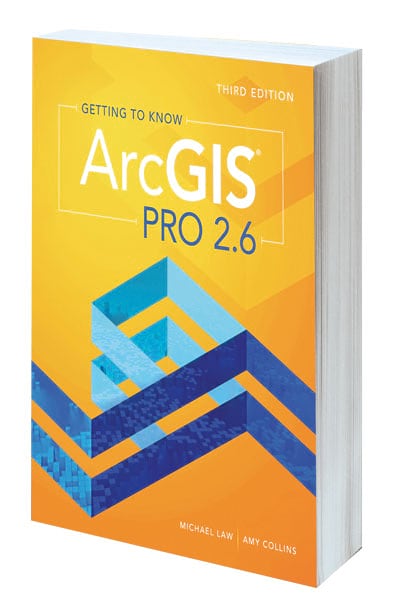
Continuing the tradition of the best-selling Getting to Know series, Getting to Know ArcGIS Pro 2.6, Third Edition, teaches new and existing GIS users how to solve problems using ArcGIS Pro. Introducing the software’s basic tools and capabilities via practical project workflows, the book helps readers learn how to analyze and present geospatial data in both 2D and 3D environments. Using figures to show each step, authors Michael Law and Amy Collins demystify complicated processes such as developing a geoprocessing model, using Python to write a script tool, and creating space-time cubes. Ideal for students, self-learners, and seasoned professionals looking to learn about new GIS technology, Getting to Know ArcGIS Pro 2.6 is a broad textbook and desk reference designed to leave users feeling confident when using ArcGIS Pro on their own. August/October 2020, 420 pp. E-book ISBN: 9781589486362 and paperback ISBN: 9781589486355.
GIS Tutorial for ArcGIS Pro 2.6
By Wilpen Gorr and Kristen Kurland

Updated for use with ArcGIS Pro 2.6, GIS Tutorial for ArcGIS Pro 2.6 is the introductory workbook for learning about GIS using ArcGIS Pro. Designed for use in classrooms or for self-learners, it is an easy-to-follow guide that employs proven teaching methods to show readers how to make maps, create and analyze spatial data, and manage operational systems. Step-by-step exercises use ArcGIS Pro, along with ArcGIS Online, ArcGIS StoryMaps, ArcGIS Dashboards, and ArcGIS Collector, to work with real-world data. “Your Turn” sections help readers reinforce what they’ve learned. Free, downloadable video lectures and lecture slides that cover the whole book are also available. July/September 2020, 448 pp. E-book ISBN: 9781589486263 and paperback ISBN: 9781589485891.
GIS Tutorial for ArcGIS Desktop 10.8
By Wilpen Gorr and Kristen Kurland
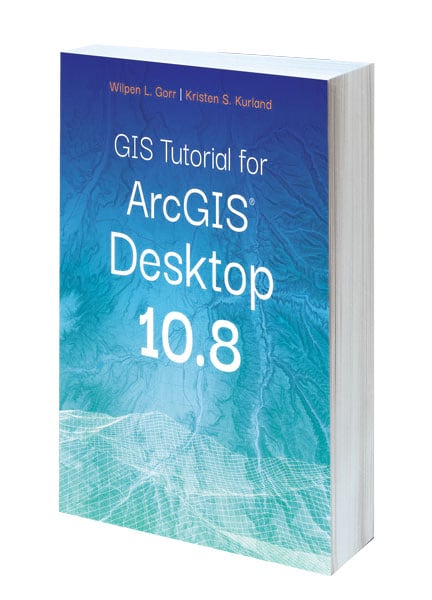
GIS Tutorial for ArcGIS Desktop 10.8, updated for use with ArcGIS Desktop 10.8.1, is a classic textbook for learning how to gather, manage, and analyze data using map visualizations and location intelligence in ArcGIS Desktop. The book, which incorporates well-established instructional techniques, introduces readers to the tools and functionality of ArcMap and ArcCatalog. Readers get to use and make maps, work with spatial data, and analyze that data by doing proximity and site suitability analyses. They also get hands-on experience with the ArcGIS 3D Analyst, ArcGIS Spatial Analyst, and ArcGIS Network Analyst extensions for ArcGIS Desktop. Detailed exercises, “Your Turn” sections, and homework assignments make GIS Tutorial for ArcGIS Desktop 10.8 ideal for the classroom or self-learners. September/December 2020, 448 pp. E-book ISBN: 9781589486157 and paperback ISBN: 9781589486140.
GIS for Science, Volume 2: Applying Mapping and Spatial Analytics
Edited by Dawn Wright and Christian Harder
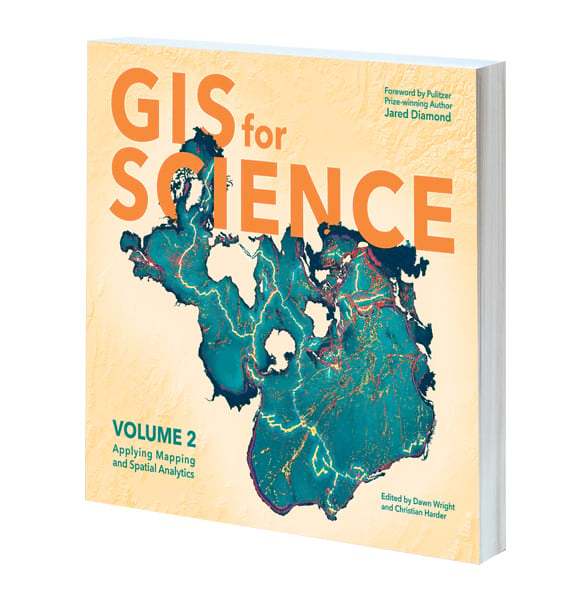
GIS for Science, Volume 2: Applying Mapping and Spatial Analytics—coedited by Esri chief scientist Dawn Wright and Esri technology writer and information designer Christian Harder, with a foreword by Pulitzer Prize winner Jared Diamond—showcases rigorous scientific research projects that employ GIS. The book’s contributors represent a cross section of scientists who employ data gathered from satellites, aircraft, ships, drones, and other remote-sensing and on-site technologies. This collated data is brought to life by GIS and the broader realm of spatial data science to study issues including epidemiology; sustainable precision agriculture; geologic processes that occur below the surface of the earth; disaster response, recovery, and resilience; and air quality monitoring. The stories in the book also show, in very practical terms, how ArcGIS software and the ArcGIS Online cloud-based system work as a comprehensive geospatial platform to support research, collaboration, spatial analysis, and science communication across many settings and communities. A supplementary website includes data along with additional maps, videos, web apps, workflows, and snippets of computer code for readers who want to learn more. October/December 2020, 250 pp. E-book ISBN: 9781589485884 and paperback ISBN: 9781589485877.
The Esri Guide to GIS Analysis, Volume 2: Spatial Measurements and Statistics, Second Edition
By Andy Mitchell and Lauren Scott Griffin

The second edition of The Esri Guide to GIS Analysis, Volume 2: Spatial Measurements and Statistics builds on volume 1 by taking users beyond visualizing patterns in maps to teaching them how to quantify patterns in a significant way. The book guides readers through some of the most common spatial statistics tasks, including measuring distributions, identifying patterns and clusters, and analyzing relationships. It also shows how spatial statistical tools can be applied in a range of disciplines, from public health to habitat conservation. With this educational aid, users can move their work past mapping and visualization to more quantitative statistical assessment. November 2020/January 2021, 250 pp. E-book ISBN: 9781589486096 and paperback ISBN: 9781589486089.
Understanding Crime: Analyzing the Geography of Crime
By Spencer Chainey
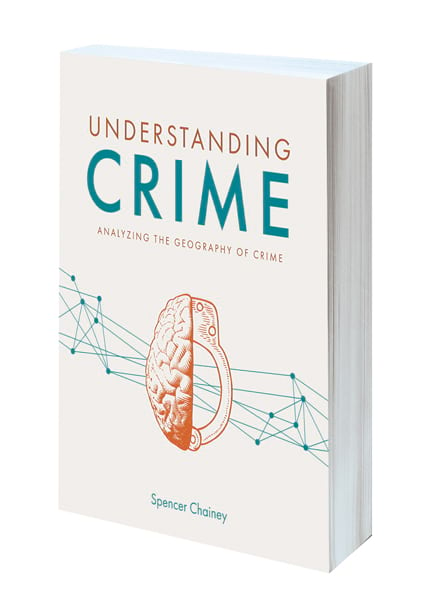
Understanding Crime: Analyzing the Geography of Crime is the first book to fully explain how to truly analyze the geography of crime. With comprehensive content that includes both new and old techniques, the book shows readers how to examine the spatial and temporal patterns of crime, analyze crime with other spatial data, and evaluate the impact of geographically targeted interventions. Topics covered in the book include the following:
- Hot spot analysis using microplace crime concentration and cluster analysis techniques
- Temporal analysis, including methods of examining the stability of crime patterns
- Analyses of troublesome places, repeat and near-repeat victimization, and persistent and emerging crime patterns
- The dispersion of crime concentration over time
Whether readers are new to analyzing the geographic patterns of crime or are experienced pros, they will benefit from learning the techniques presented in Understanding Crime. November 2020/January 2021, 500 pp. E-book ISBN: 9781589485853 and paperback ISBN: 9781589485846.
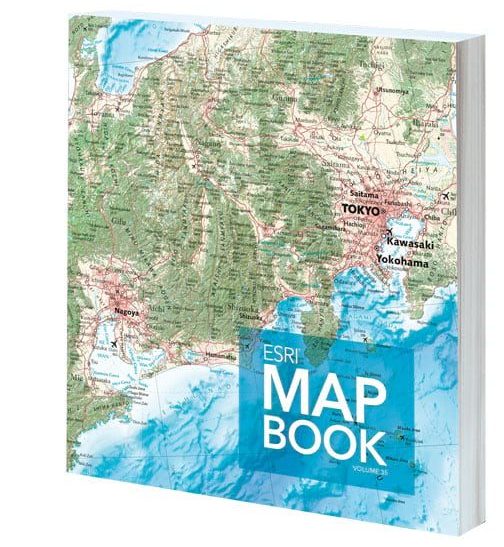
Esri Map Book, Volume 35
By Esri
Every year, works from mapmakers around the world are selected for the Esri Map Book to demonstrate how GIS technology helps governments, businesses, and individuals. Esri Map Book, Volume 35, continues this tradition, showcasing maps and apps that employ ArcGIS technology to evaluate the sustainability of resources, determine efficient transportation routes, mitigate the effects of natural disasters, and more. Each map or app includes a description of how it was produced. August 2020, 168 pp. Paperback ISBN: 9781589485860.
STEAM at Work! Children’s Book Series
The STEAM at Work! series, for grades 1–5, opens children up to new ideas for channeling their passions, particularly into science, technology, engineering, art, and math (STEAM) careers. Each book demonstrates different environmental and social issues, which the characters use their skills to solve, encouraging critical and creative thinking about the world. Just like the characters in the series, readers will be inspired to make a positive impact on their communities now and in the future. Following on the first book, Lindsey the GIS Professional, meet three of Lindsey’s friends.

Will the Civil Engineer
By Chadd Kahlsdorf
Will’s dad is a civil engineer who uses math and science to make the world a better place. Follow along as Will learns that everything that gets built requires an engineer and how he can be one, too! September 2020, 24 pp. Paperback ISBN: 9781589486430.

Sam the Landscape Architect
By Shannon Gapp
Sam loves to design things. She plans to be a landscape architect one day so she can help make the world green. See how she uses her imagination to create parks and gardens that improve her community. October 2020, 24 pp. Paperback ISBN: 9781589486423.

Parker the Planner
By Madeline Peck
Parker’s city is a mess. It’s full of traffic and has no sidewalks or parks. But Parker has a plan! He’ll build his own city—with parks, zoos, transportation, and environmental benefits—and show kids how they can help create change. October 2020, 24 pp. Paperback ISBN: 9781589486416.


